The macroeconomic impact of payment cards
Abstract
This paper focuses on the macroeconomic benefits of the transition from paper-based to electronic payments, examining the impact of payments using debit and credit cards on household consumption. The empirical model is based on the work of Zandi et al.1, with a considerably richer dataset in terms of the number of years and countries. The results confirm that the use of payment cards has a positive impact on private consumption and gross domestic product (GDP), while finding a meaningful effect for both consumption and GDP — and a larger impact for both than found by Zandi et al. The analysis indicates that the transition to electronic payments matters for both the economy as a whole ( for GDP) and for individual families (through higher consumption). Overall, card penetration contributed to global GDP by an annual average of 0.243 percentage points, which translates into US$160bn per year. The contribution of card usage to global income approximately amounts to the 2014 GDP of Kuwait, and is slightly lower than the 2014 GDP of Bangladesh and Vietnam (US$183bn and US$185bn, respectively) and slightly higher than the 2014 GDP of Hungary and Ukraine (US$136bn and US$130bn, respectively).
The full article is available to subscribers to the journal.
Author's Biography
Holti Banka is an adjunct professor at the School of Public Policy, University of Maryland, and a consultant for the World Bank’s Payment Systems Development Group (Finance & Markets). He holds a PhD in economic policy and international development from the University of Maryland. His research and expertise is on financial inclusion and payment systems, and specifically on the cost structure of using different payment instruments and the empirical exploration of the macroeconomic benefits of electronic payments.
